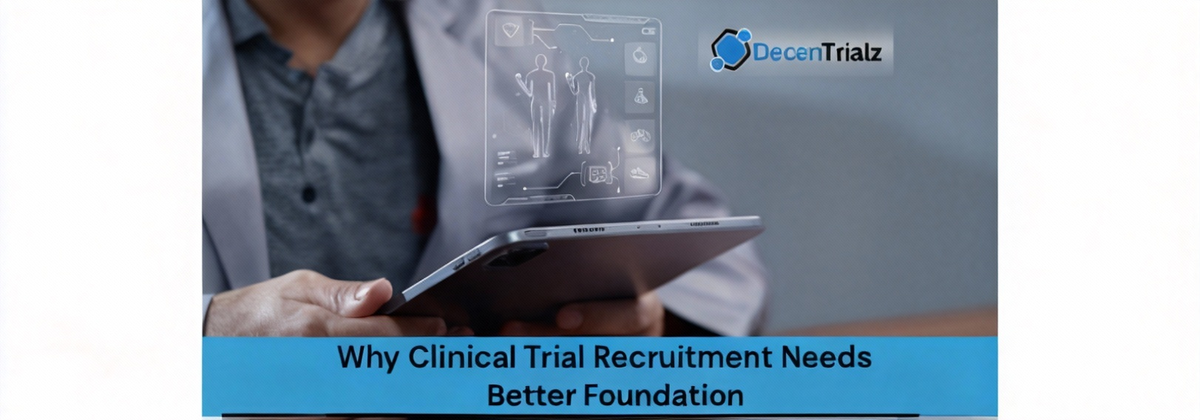Clinical trial recruitment challenges continue to slow down research across the United States, even as clinical science moves forward. Many studies still face enrollment delays, and teams end up spending extra time and money trying to stay on track. Anyone who has worked on a study knows how quickly a slow start affects everything that follows.
This problem is not for a lack of effort. Sponsors, sites, and coordinators work hard every day. The challenge is that the overall recruitment system hasn’t kept up with how research now works. People struggle to understand studies, sites handle too much manual work, and teams often don’t have a clear view of early activity. Because of this, studies lose momentum before they even begin.
This is why clinical research needs a smoother, clearer way to guide people from interest to qualification. DecenTrialz was created to support exactly this part of the journey.
What Commonly Slows Down Recruitment
Recruitment breaks down for several reasons. When you look at how people find a study, how they reach a site, and what information they receive, it becomes clear that many issues happen at the same time.
Many people don’t know where to look
Most people don’t know clinical trials exist. Even those who are willing to join often don’t know where to search or how to see if a study is right for them. As a result, many potential participants never enter the funnel at all.
Study information can feel too overwhelming
Long descriptions, medical terms, and unclear details can cause confusion. This makes people lose interest or stop halfway through, even if they might have been a good match.
Sites carry a heavy manual workload
Coordinators spend hours sorting through inquiries, calling participants, and checking basic criteria. These repetitive tasks slow down progress and create bottlenecks. It’s frustrating for teams who are already doing their best.
A high number of screen-fails
When pre-screening isn’t clear or structured, many people reach the site only to learn they don’t qualify. This wastes time for both participants and site staff.
Study teams don’t always see the full picture
Recruitment details are often stored in different places. When everything is scattered, it becomes hard to see progress or understand where participants drop off. These issues add up over time.
Communication feels disconnected
When several steps depend on different tools or manual follow-ups, delays and misunderstandings become more common. This reduces the quality of the early participant experience.
Together, these issues slow enrollment and make it harder for studies to maintain momentum.
Why These Problems Affect Timelines
Once the early stage slows down, the effects spread quickly:
- Study activities get pushed back
- Budgets increase
- Teams feel stretched
- Planning becomes more difficult
- Protocol changes become more likely
- Sites experience extra pressure
These delays weaken the entire timeline. A strong start helps studies maintain momentum, which is why predictable recruitment is so important.
Why a Better System Is Needed Now
Trials today have more specific criteria and more diverse populations to reach. People also expect a simpler digital experience. Yet the early journey still depends on old methods like phone calls, emails, and scattered tools.
This approach worked years ago, but it no longer fits the pace of modern research. Because of this, studies need:
- Simpler ways for people to understand studies
- A clearer path from interest to pre-screening
- Less manual work for sites
- More organized information for study teams
- A smoother overall experience
This is what DecenTrialz aims to support.
If you’d like to see how a clearer, more organized early enrollment process can help your studies, you can learn more about DecenTrialz on our platform page.
How DecenTrialz Improves the Early Enrollment Process
DecenTrialz strengthens the early part of recruitment, where most delays occur. It brings together trial discovery, digital pre-screening, and organized information in one simple experience.
Easier ways for people to find and understand studies
Participants can browse studies in plain language. They can quickly see what the study involves, who it’s for, and what the basic requirements are. This reduces confusion and helps more people stay engaged.
Guided digital pre-screening
Instead of long forms or unclear questions, participants follow a simple, structured process that helps them understand whether the study might fit them.
AI-supported logic helps improve match quality and reduces unnecessary site visits. This reduces back-and-forth between teams and supports a smoother screening experience.
Clear and easy-to-read enrollment information for teams
DecenTrialz shows enrollment details in a clear way. Teams can see how many people showed interest, how pre-screening went, and how participants are moving through each step. This gives teams a cleaner overview without adding complexity.
A smoother experience for participants
The process is easy to understand. People know what to do next and don’t get stuck on confusing medical words. As a result, more participants complete each step.
Built with strong security standards
The platform follows HIPAA requirements and is ISO 27001 certified, which supports secure handling of participant information.
Why This Approach Works for Today’s Research Needs
A clearer and more structured early funnel helps reduce long-standing issues:
- Participants understand studies better
- Drop-offs decrease
- Matches become more accurate
- Sites save time
- Study teams get a cleaner overview
- Enrollment becomes steadier
All of this helps studies maintain momentum from the very beginning.
A Better Start Leads to Better Enrollment
Recruitment will always be challenging, but it doesn’t have to be unpredictable. As trials grow more complex, the systems supporting them must become simpler and more organized.
DecenTrialz was built to support this shift by improving the early part of enrollment, where clarity matters most. A better start helps studies move faster, stay on schedule, and reach the people who need them.
Explore what DecenTrialz offers and see how our clinical trial recruitment marketplace can help you reduce delays, improve clarity, and strengthen early enrollment.






